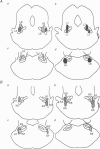Abstract
1. The parabrachial nucleus (PBN) is thought to play an important role in cardiorespiratory control. However, the circumstances under which it affects ventilation are still not known. The purpose of the present study was to investigate how the PBN modulates the ventilatory responses to hypercapnia, hypoxia or a resistive load in awake rats with chemical lesions of the PBN. 2. In three groups of rats (with lateral PBN lesion, with Kölliker-Fuse nucleus lesion and control), ventilation was measured under various conditions. 3. There was no difference in the breathing of normal room air in any of the groups. However, the lesioned groups showed a reduced ventilatory response to hyperoxic hypercapnia (inspired CO2 fractions (FI,CO2) of 3, 5, 8 and 10%) and to graded hypoxia (inspired O2 fractions (FI,O2) of 16, 12, 10 and 8%) compared with the control group. The control group showed a biphasic response to sustained hypoxia (FI,O2 at 10% for 30 min), known as 'hypoxic depression', while the lesioned groups showed moderate ventilatory exaggeration throughout hypoxia. In response to a resistive load, the lateral PBN lesion group showed no change in ventilatory compensation. 4. The PBN appeared to have a considerable influence on ventilation stimulated in various ways during wakefulness.
Full text
PDF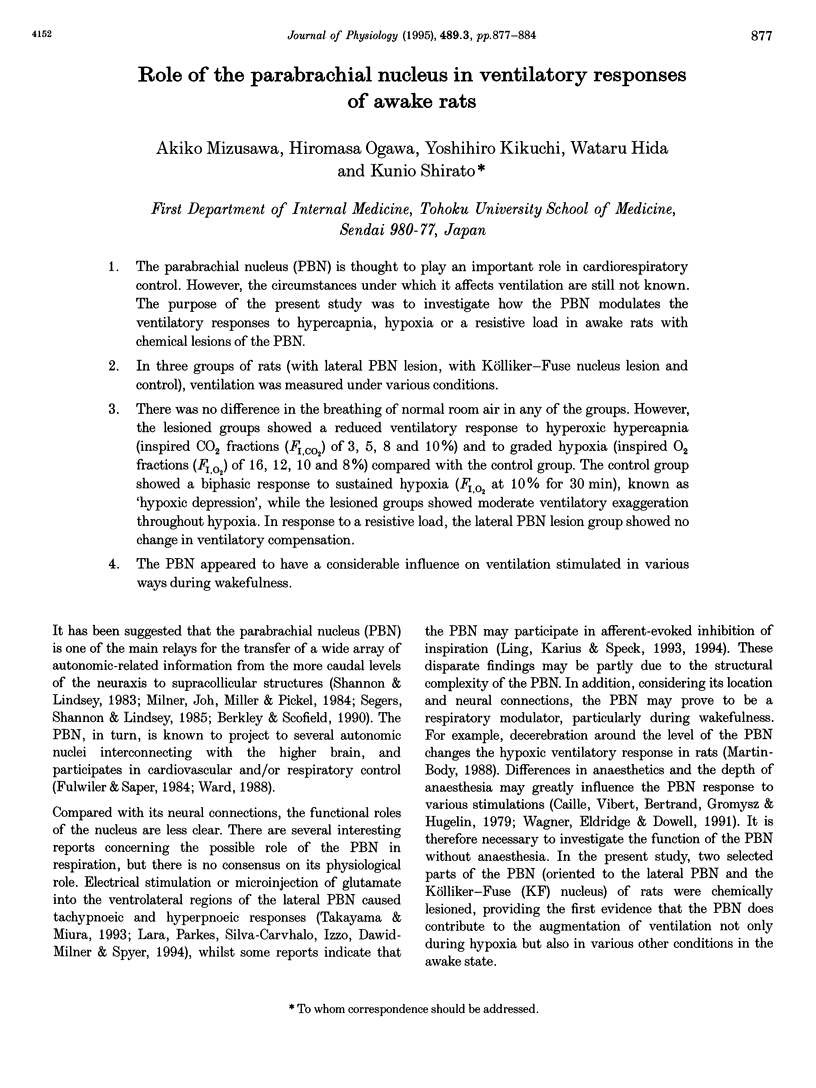
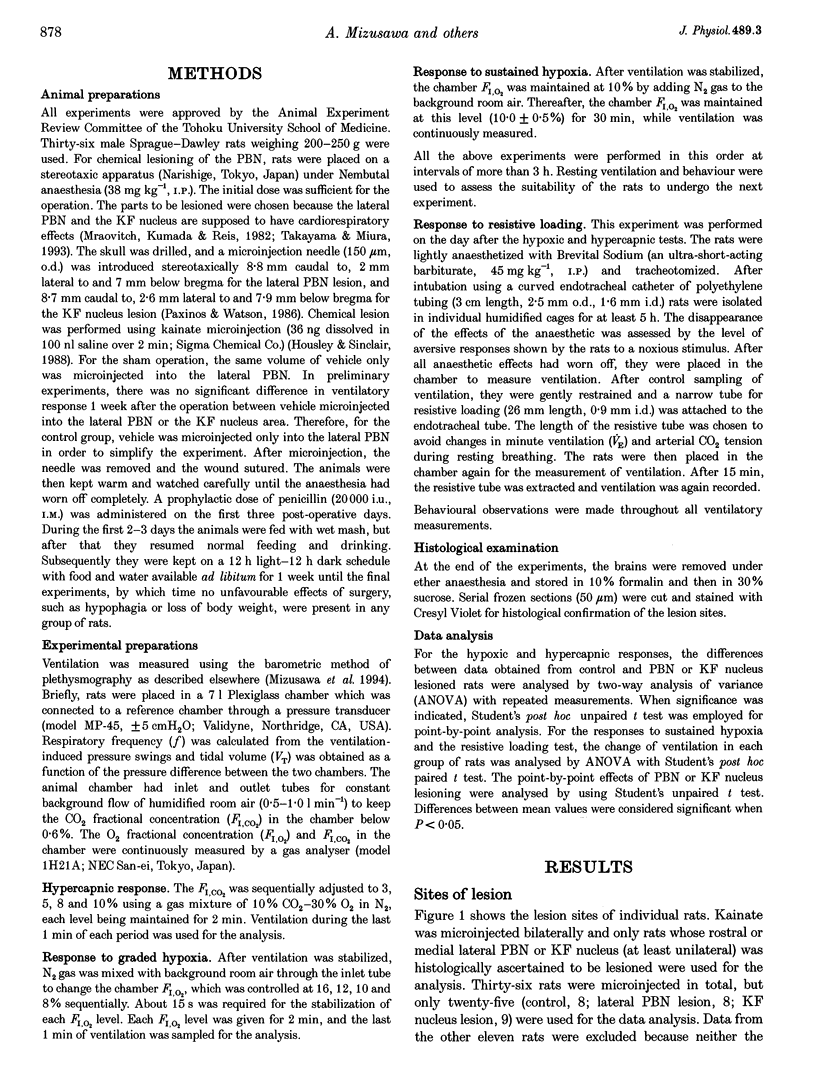
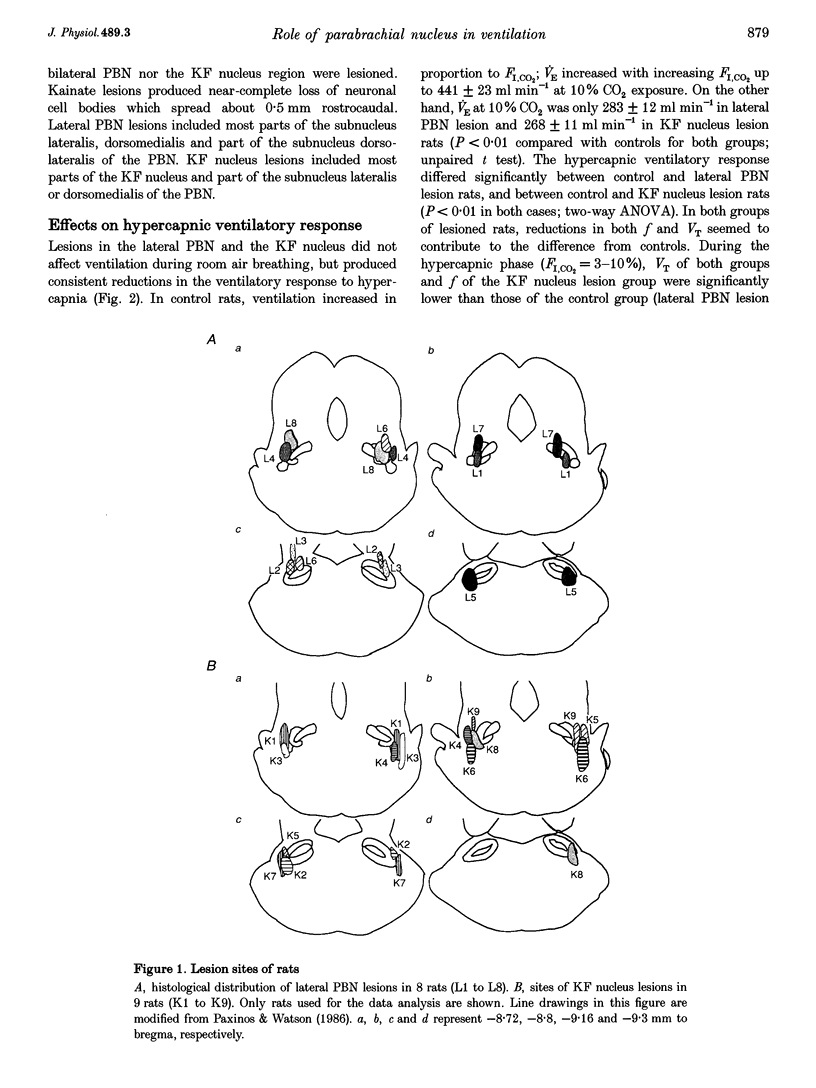
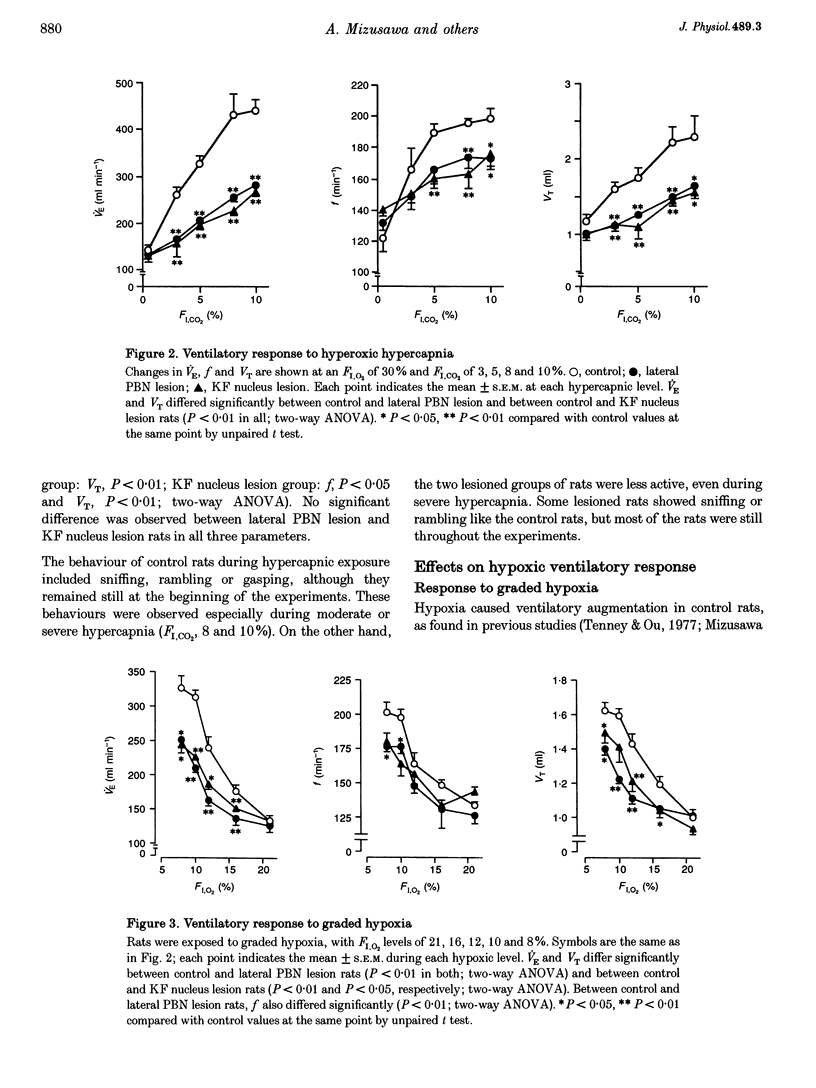
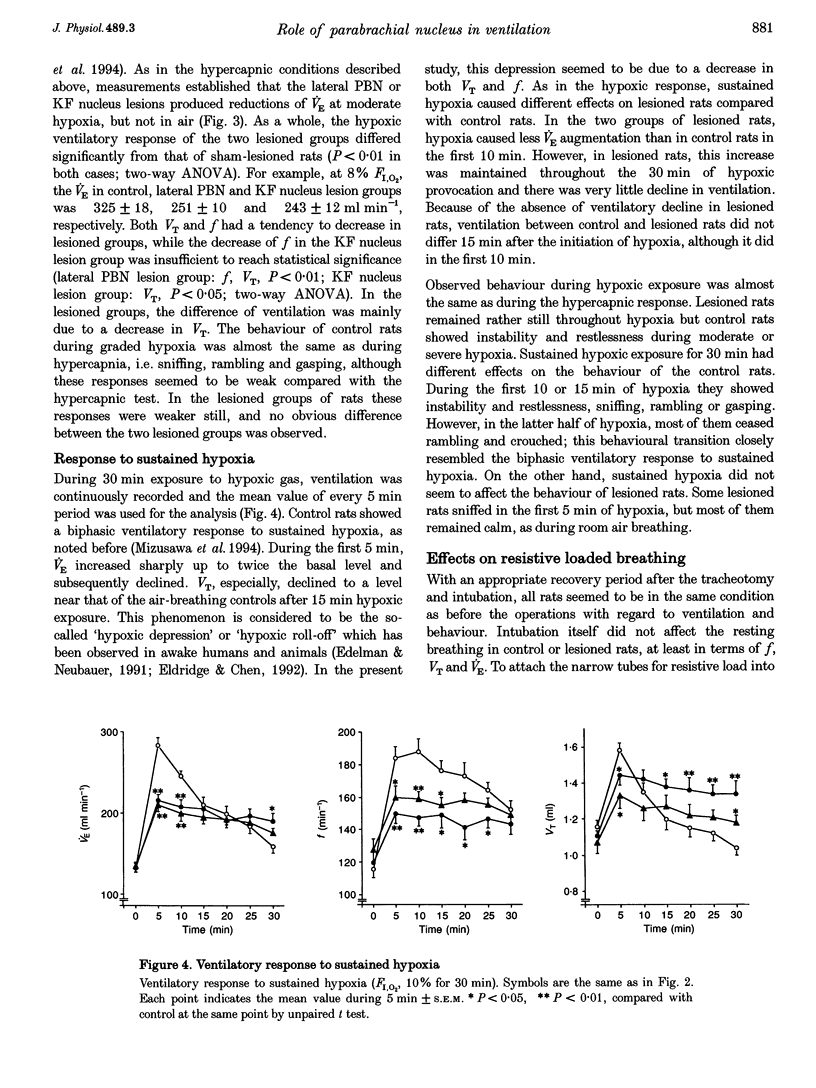
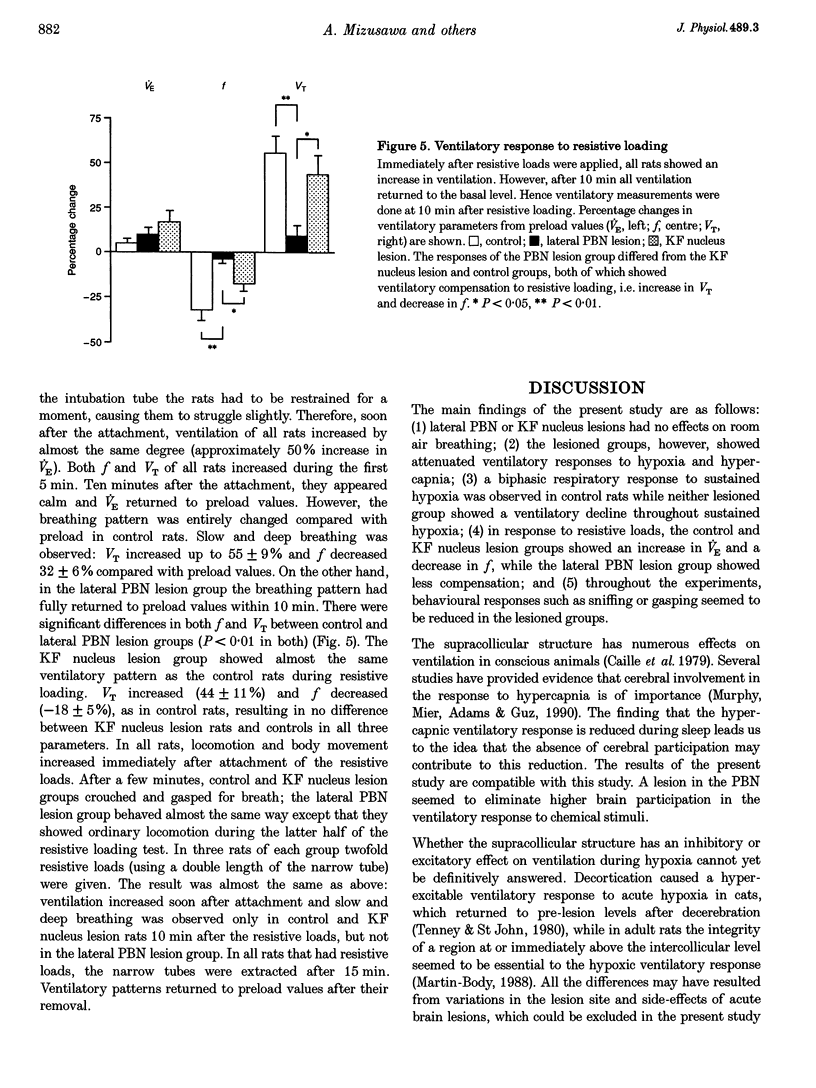
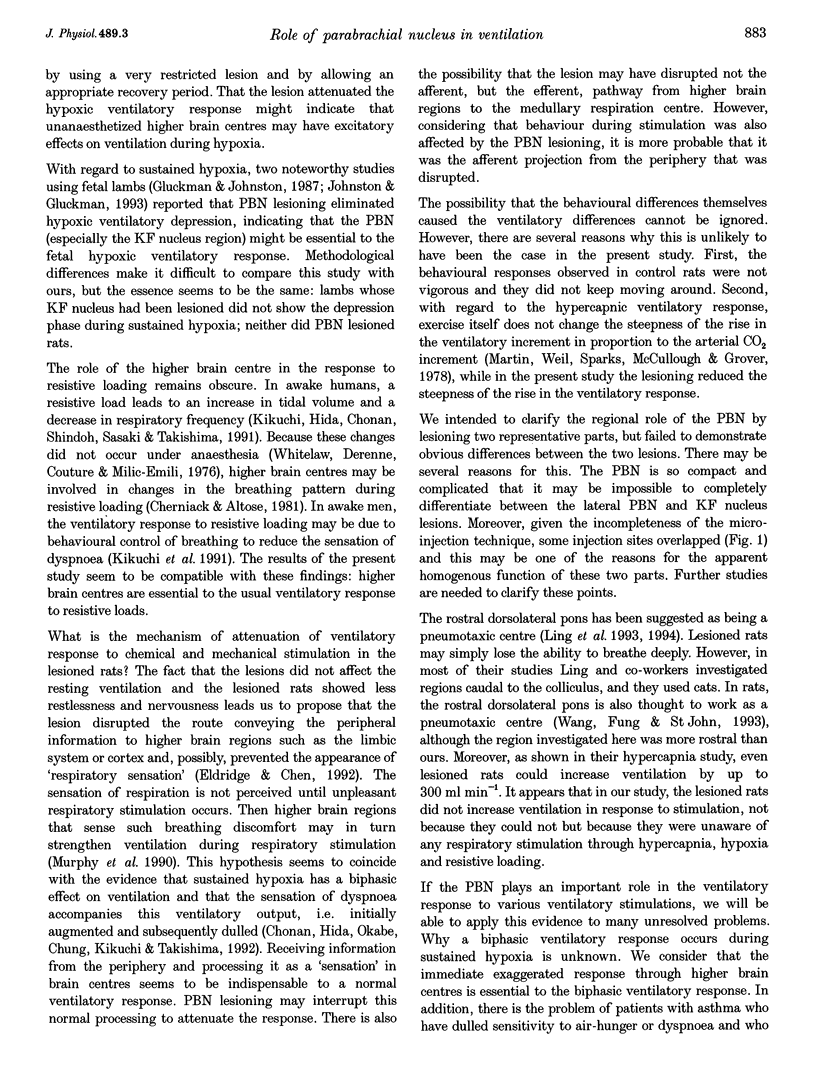
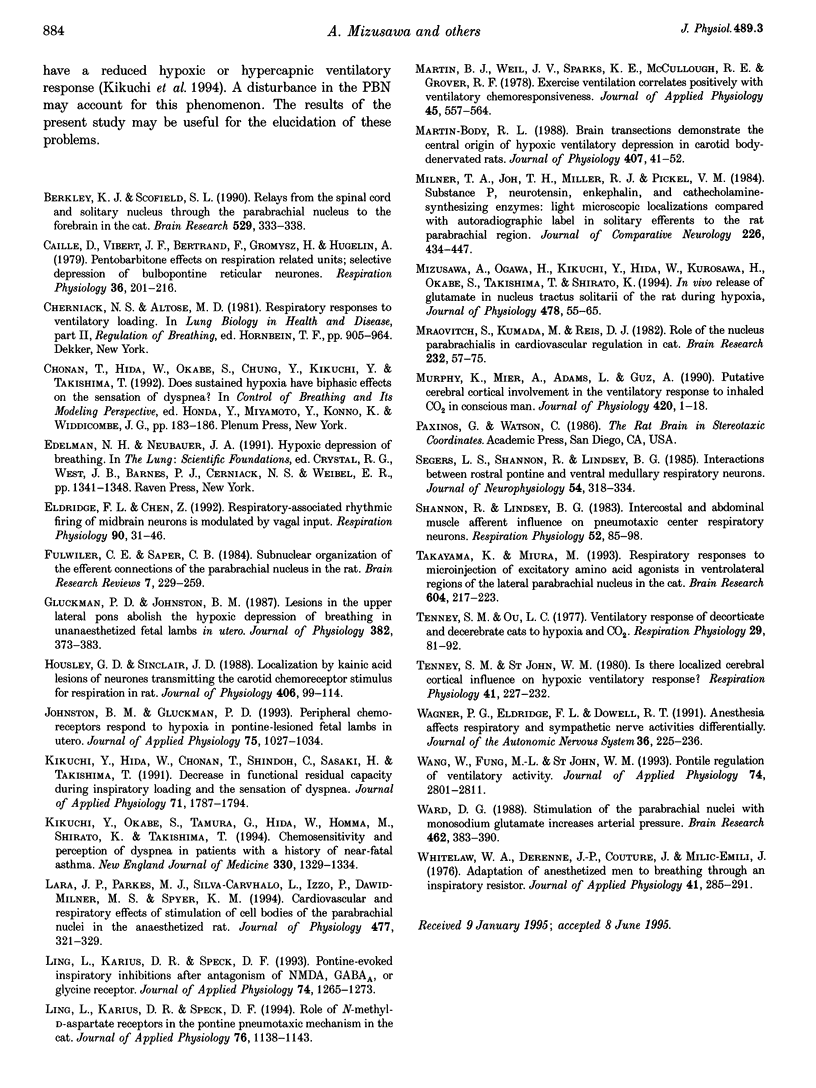
Images in this article
Selected References
These references are in PubMed. This may not be the complete list of references from this article.
- Berkley K. J., Scofield S. L. Relays from the spinal cord and solitary nucleus through the parabrachial nucleus to the forebrain in the cat. Brain Res. 1990 Oct 8;529(1-2):333–338. doi: 10.1016/0006-8993(90)90847-5. [DOI] [PubMed] [Google Scholar]
- Caille D., Vibert J. F., Bertrand F., Gromysz H., Hugelin A. Pentobarbitone effects on respiration related units; selective depression of bulbopontine reticular neurones. Respir Physiol. 1979 Feb;36(2):201–216. doi: 10.1016/0034-5687(79)90025-2. [DOI] [PubMed] [Google Scholar]
- Eldridge F. L., Chen Z. Respiratory-associated rhythmic firing of midbrain neurons is modulated by vagal input. Respir Physiol. 1992 Oct;90(1):31–46. doi: 10.1016/0034-5687(92)90132-g. [DOI] [PubMed] [Google Scholar]
- Fulwiler C. E., Saper C. B. Subnuclear organization of the efferent connections of the parabrachial nucleus in the rat. Brain Res. 1984 Aug;319(3):229–259. doi: 10.1016/0165-0173(84)90012-2. [DOI] [PubMed] [Google Scholar]
- Gluckman P. D., Johnston B. M. Lesions in the upper lateral pons abolish the hypoxic depression of breathing in unanaesthetized fetal lambs in utero. J Physiol. 1987 Jan;382:373–383. doi: 10.1113/jphysiol.1987.sp016372. [DOI] [PMC free article] [PubMed] [Google Scholar]
- Housley G. D., Sinclair J. D. Localization by kainic acid lesions of neurones transmitting the carotid chemoreceptor stimulus for respiration in rat. J Physiol. 1988 Dec;406:99–114. doi: 10.1113/jphysiol.1988.sp017371. [DOI] [PMC free article] [PubMed] [Google Scholar]
- Johnston B. M., Gluckman P. D. Peripheral chemoreceptors respond to hypoxia in pontine-lesioned fetal lambs in utero. J Appl Physiol (1985) 1993 Sep;75(3):1027–1034. doi: 10.1152/jappl.1993.75.3.1027. [DOI] [PubMed] [Google Scholar]
- Kikuchi Y., Hida W., Chonan T., Shindoh C., Sasaki H., Takishima T. Decrease in functional residual capacity during inspiratory loading and the sensation of dyspnea. J Appl Physiol (1985) 1991 Nov;71(5):1787–1794. doi: 10.1152/jappl.1991.71.5.1787. [DOI] [PubMed] [Google Scholar]
- Kikuchi Y., Okabe S., Tamura G., Hida W., Homma M., Shirato K., Takishima T. Chemosensitivity and perception of dyspnea in patients with a history of near-fatal asthma. N Engl J Med. 1994 May 12;330(19):1329–1334. doi: 10.1056/NEJM199405123301901. [DOI] [PubMed] [Google Scholar]
- Lara J. P., Parkes M. J., Silva-Carvhalo L., Izzo P., Dawid-Milner M. S., Spyer K. M. Cardiovascular and respiratory effects of stimulation of cell bodies of the parabrachial nuclei in the anaesthetized rat. J Physiol. 1994 Jun 1;477(Pt 2):321–329. doi: 10.1113/jphysiol.1994.sp020193. [DOI] [PMC free article] [PubMed] [Google Scholar]
- Ling L., Karius D. R., Speck D. F. Pontine-evoked inspiratory inhibitions after antagonism of NMDA, GABAA, or glycine receptor. J Appl Physiol (1985) 1993 Mar;74(3):1265–1273. doi: 10.1152/jappl.1993.74.3.1265. [DOI] [PubMed] [Google Scholar]
- Ling L., Karius D. R., Speck D. F. Role of N-methyl-D-aspartate receptors in the pontine pneumotaxic mechanism in the cat. J Appl Physiol (1985) 1994 Mar;76(3):1138–1143. doi: 10.1152/jappl.1994.76.3.1138. [DOI] [PubMed] [Google Scholar]
- Martin-Body R. L. Brain transections demonstrate the central origin of hypoxic ventilatory depression in carotid body-denervated rats. J Physiol. 1988 Dec;407:41–52. doi: 10.1113/jphysiol.1988.sp017402. [DOI] [PMC free article] [PubMed] [Google Scholar]
- Martin B. J., Weil J. V., Sparks K. E., McCullough R. E., Grover R. F. Exercise ventilation correlates positively with ventilatory chemoresponsiveness. J Appl Physiol Respir Environ Exerc Physiol. 1978 Oct;45(4):557–564. doi: 10.1152/jappl.1978.45.4.557. [DOI] [PubMed] [Google Scholar]
- Milner T. A., Joh T. H., Miller R. J., Pickel V. M. Substance P, neurotensin, enkephalin, and catecholamine-synthesizing enzymes: light microscopic localizations compared with autoradiographic label in solitary efferents to the rat parabrachial region. J Comp Neurol. 1984 Jul 1;226(3):434–447. doi: 10.1002/cne.902260311. [DOI] [PubMed] [Google Scholar]
- Mraovitch S., Kumada M., Reis D. J. Role of the nucleus parabrachialis in cardiovascular regulation in cat. Brain Res. 1982 Jan 28;232(1):57–75. doi: 10.1016/0006-8993(82)90610-2. [DOI] [PubMed] [Google Scholar]
- Murphy K., Mier A., Adams L., Guz A. Putative cerebral cortical involvement in the ventilatory response to inhaled CO2 in conscious man. J Physiol. 1990 Jan;420:1–18. doi: 10.1113/jphysiol.1990.sp017898. [DOI] [PMC free article] [PubMed] [Google Scholar]
- Segers L. S., Shannon R., Lindsey B. G. Interactions between rostral pontine and ventral medullary respiratory neurons. J Neurophysiol. 1985 Aug;54(2):318–334. doi: 10.1152/jn.1985.54.2.318. [DOI] [PubMed] [Google Scholar]
- Shannon R., Lindsey B. G. Intercostal and abdominal muscle afferent influence on pneumotaxic center respiratory neurons. Respir Physiol. 1983 Apr;52(1):85–98. doi: 10.1016/0034-5687(83)90138-x. [DOI] [PubMed] [Google Scholar]
- Takayama K., Miura M. Respiratory responses to microinjection of excitatory amino acid agonists in ventrolateral regions of the lateral parabrachial nucleus in the cat. Brain Res. 1993 Feb 26;604(1-2):217–223. doi: 10.1016/0006-8993(93)90372-t. [DOI] [PubMed] [Google Scholar]
- Tenney S. M., Ou L. C. Ventilatory response of decorticate and decerebrate cats to hypoxia and CO2. Respir Physiol. 1977 Feb;29(1):81–92. doi: 10.1016/0034-5687(77)90119-0. [DOI] [PubMed] [Google Scholar]
- Tenney S. M., St John W. M. Is there localized cerebral cortical influence on hypoxic ventilatory response? Respir Physiol. 1980 Aug;41(2):227–232. doi: 10.1016/0034-5687(80)90055-9. [DOI] [PubMed] [Google Scholar]
- Wagner P. G., Eldridge F. L., Dowell R. T. Anesthesia affects respiratory and sympathetic nerve activities differentially. J Auton Nerv Syst. 1991 Dec;36(3):225–236. doi: 10.1016/0165-1838(91)90046-6. [DOI] [PubMed] [Google Scholar]
- Wang W., Fung M. L., St John W. M. Pontile regulation of ventilatory activity in the adult rat. J Appl Physiol (1985) 1993 Jun;74(6):2801–2811. doi: 10.1152/jappl.1993.74.6.2801. [DOI] [PubMed] [Google Scholar]
- Ward D. G. Stimulation of the parabrachial nuclei with monosodium glutamate increases arterial pressure. Brain Res. 1988 Oct 18;462(2):383–390. doi: 10.1016/0006-8993(88)90570-7. [DOI] [PubMed] [Google Scholar]
- Whitelaw W. A., Derenne J. P., Couture J., Milic-Emili J. Adaptation of anesthetized men to breathing through an inspiratory resistor. J Appl Physiol. 1976 Sep;41(3):285–291. doi: 10.1152/jappl.1976.41.3.285. [DOI] [PubMed] [Google Scholar]



